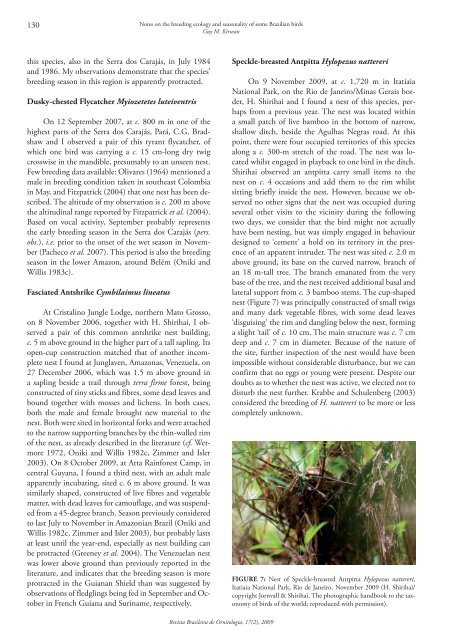art01 - omena júnior.indd - Sociedade Brasileira de Ornitologia
art01 - omena júnior.indd - Sociedade Brasileira de Ornitologia
art01 - omena júnior.indd - Sociedade Brasileira de Ornitologia
- No tags were found...
Create successful ePaper yourself
Turn your PDF publications into a flip-book with our unique Google optimized e-Paper software.
130 Notes on the breeding ecology and seasonality of some Brazilian birdsGuy M. Kirwanthis species, also in the Serra dos Carajás, in July 1984and 1986. My observations <strong>de</strong>monstrate that the species’breeding season in this region is apparently protracted.Dusky-chested Flycatcher Myiozetetes luteiventrisOn 12 September 2007, at c. 800 m in one of thehighest parts of the Serra dos Carajás, Pará, C.G. Bradshawand I observed a pair of this tyrant flycatcher, ofwhich one bird was carrying a c. 15 cm-long dry twigcrosswise in the mandible, presumably to an unseen nest.Few breeding data available: Olivares (1964) mentioned amale in breeding condition taken in southeast Colombiain May, and Fitzpatrick (2004) that one nest has been <strong>de</strong>scribed.The altitu<strong>de</strong> of my observation is c. 200 m abovethe altitudinal range reported by Fitzpatrick et al. (2004).Based on vocal activity, September probably representsthe early breeding season in the Serra dos Carajás (pers.obs.), i.e. prior to the onset of the wet season in November(Pacheco et al. 2007). This period is also the breedingseason in the lower Amazon, around Belém (Oniki andWillis 1983c).Fasciated Antshrike Cymbilaimus lineatusAt Cristalino Jungle Lodge, northern Mato Grosso,on 8 November 2006, together with H. Shirihai, I observeda pair of this common antshrike nest building,c. 5 m above ground in the higher part of a tall sapling. Itsopen-cup construction matched that of another incompletenest I found at Junglaven, Amazonas, Venezuela, on27 December 2006, which was 1.5 m above ground ina sapling besi<strong>de</strong> a trail through terra firme forest, beingconstructed of tiny sticks and fibres, some <strong>de</strong>ad leaves andbound together with mosses and lichens. In both cases,both the male and female brought new material to thenest. Both were sited in horizontal forks and were attachedto the narrow supporting branches by the thin-walled rimof the nest, as already <strong>de</strong>scribed in the literature (cf. Wetmore1972, Oniki and Willis 1982c, Zimmer and Isler2003). On 8 October 2009, at Atta Rainforest Camp, incentral Guyana, I found a third nest, with an adult maleapparently incubating, sited c. 6 m above ground. It wassimilarly shaped, constructed of live fibres and vegetablematter, with <strong>de</strong>ad leaves for camouflage, and was suspen<strong>de</strong>dfrom a 45-<strong>de</strong>gree branch. Season previously consi<strong>de</strong>redto last July to November in Amazonian Brazil (Oniki andWillis 1982c, Zimmer and Isler 2003), but probably lastsat least until the year-end, especially as nest building canbe protracted (Greeney et al. 2004). The Venezuelan nestwas lower above ground than previously reported in theliterature, and indicates that the breeding season is moreprotracted in the Guianan Shield than was suggested byobservations of fledglings being fed in September and Octoberin French Guiana and Suriname, respectively.Speckle-breasted Antpitta Hylopezus nattereriOn 9 November 2009, at c. 1,720 m in ItatiaiaNational Park, on the Rio <strong>de</strong> Janeiro/Minas Gerais bor<strong>de</strong>r,H. Shirihai and I found a nest of this species, perhapsfrom a previous year. The nest was located withina small patch of live bamboo in the bottom of narrow,shallow ditch, besi<strong>de</strong> the Agulhas Negras road. At thispoint, there were four occupied territories of this speciesalong a c. 300‐m stretch of the road. The nest was locatedwhilst engaged in playback to one bird in the ditch.Shirihai observed an antpitta carry small items to thenest on c. 4 occasions and add them to the rim whilstsitting briefly insi<strong>de</strong> the nest. However, because we observedno other signs that the nest was occupied duringseveral other visits to the vicinity during the followingtwo days, we consi<strong>de</strong>r that the bird might not actuallyhave been nesting, but was simply engaged in behaviour<strong>de</strong>signed to ‘cement’ a hold on its territory in the presenceof an apparent intru<strong>de</strong>r. The nest was sited c. 2.0 mabove ground, its base on the curved narrow, branch ofan 18 m-tall tree. The branch emanated from the verybase of the tree, and the nest received additional basal andlateral support from c. 3 bamboo stems. The cup-shapednest (Figure 7) was principally constructed of small twigsand many dark vegetable fibres, with some <strong>de</strong>ad leaves‘disguising’ the rim and dangling below the nest, forminga slight ‘tail’ of c. 10 cm. The main structure was c. 7 cm<strong>de</strong>ep and c. 7 cm in diameter. Because of the nature ofthe site, further inspection of the nest would have beenimpossible without consi<strong>de</strong>rable disturbance, but we canconfirm that no eggs or young were present. Despite ourdoubts as to whether the nest was active, we elected not todisturb the nest further. Krabbe and Schulenberg (2003)consi<strong>de</strong>red the breeding of H. nattereri to be more or lesscompletely unknown.Figure 7: Nest of Speckle-breasted Antpitta Hylopezus nattereri,Itatiaia National Park, Rio <strong>de</strong> Janeiro, November 2009 (H. Shirihai/copyright Jornvall & Shirihai, The photographic handbook to the taxonomyof birds of the world; reproduced with permission).Revista <strong>Brasileira</strong> <strong>de</strong> <strong>Ornitologia</strong>, 17(2), 2009
















